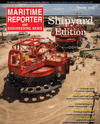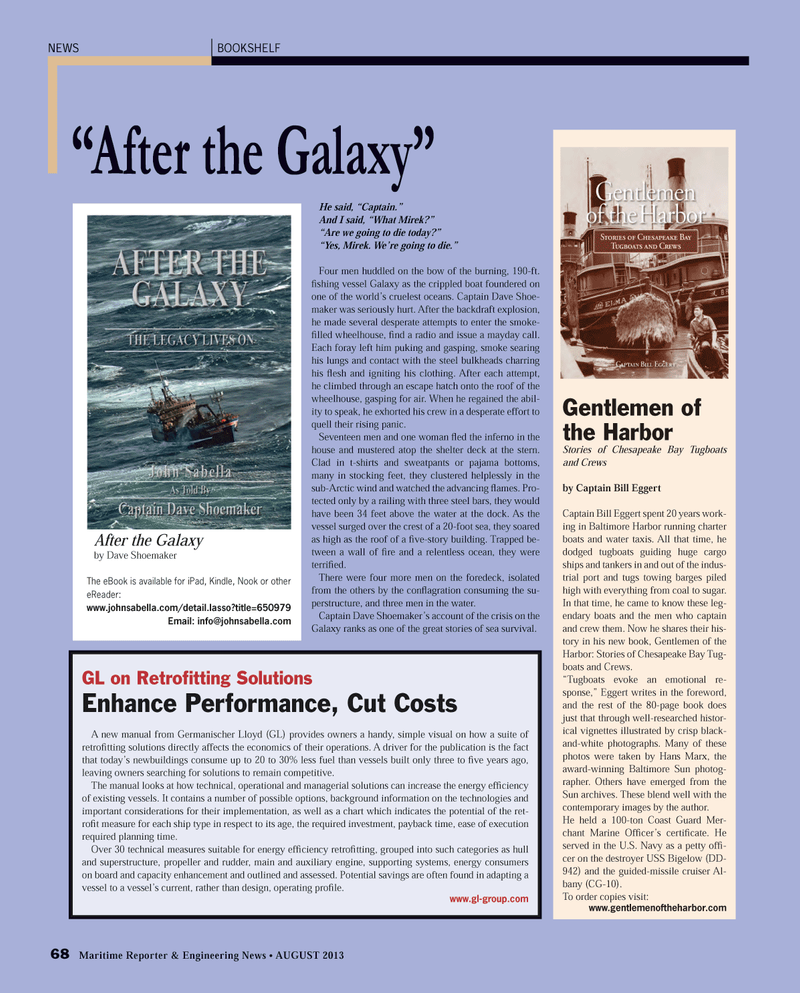
Page 68: of Maritime Reporter Magazine (August 2013)
Shipyard Edition
Read this page in Pdf, Flash or Html5 edition of August 2013 Maritime Reporter Magazine
NEWSBOOKSHELFHe said, ?Captain.?And I said, ?What Mirek???Are we going to die today???Yes, Mirek. We?re going to die.? Four men huddled on the bow of the burning, 190-ft. Þ shing vessel Galaxy as the crippled boat foundered on one of the world?s cruelest oceans. Captain Dave Shoe- maker was seriously hurt. After the backdraft explosion, he made several desperate attempts to enter the smoke-Þ lled wheelhouse, Þ nd a radio and issue a mayday call. Each foray left him puking and gasping, smoke searing his lungs and contact with the steel bulkheads charring his ß esh and igniting his clothing. After each attempt, he climbed through an escape hatch onto the roof of the wheelhouse, gasping for air. When he regained the abil- ity to speak, he exhorted his crew in a desperate effort to quell their rising panic. Seventeen men and one woman ß ed the inferno in the house and mustered atop the shelter deck at the stern. Clad in t-shirts and sweatpants or pajama bottoms, many in stocking feet, they clustered helplessly in the sub-Arctic wind and watched the advancing ß ames. Pro- tected only by a railing with three steel bars, they would have been 34 feet above the water at the dock. As the vessel surged over the crest of a 20-foot sea, they soared as high as the roof of a Þ ve-story building. Trapped be- tween a wall of Þ re and a relentless ocean, they were terriÞ ed. There were four more men on the foredeck, isolated from the others by the conß agration consuming the su- perstructure, and three men in the water. Captain Dave Shoemaker?s account of the crisis on the Galaxy ranks as one of the great stories of sea survival. ?After the Galaxy? Gentlemen of the HarborStories of Chesapeake Bay Tugboats and Crews by Captain Bill EggertCaptain Bill Eggert spent 20 years work-ing in Baltimore Harbor running charter boats and water taxis. All that time, he dodged tugboats guiding huge cargo ships and tankers in and out of the indus-trial port and tugs towing barges piled high with everything from coal to sugar. In that time, he came to know these leg-endary boats and the men who captain and crew them. Now he shares their his-tory in his new book, Gentlemen of the Harbor: Stories of Chesapeake Bay Tug- boats and Crews.?Tugboats evoke an emotional re- sponse,? Eggert writes in the foreword, and the rest of the 80-page book does just that through well-researched histor- ical vignettes illustrated by crisp black-and-white photographs. Many of these photos were taken by Hans Marx, the award-winning Baltimore Sun photog-rapher. Others have emerged from the Sun archives. These blend well with the contemporary images by the author. He held a 100-ton Coast Guard Mer- chant Marine OfÞ cer?s certi Þ cate. He served in the U.S. Navy as a petty ofÞ -cer on the destroyer USS Bigelow (DD-942) and the guided-missile cruiser Al- bany (CG-10).To order copies visit: www.gentlemenoftheharbor.com 68 Maritime Reporter & Engineering News ? AUGUST 2013 After the Galaxy by Dave ShoemakerThe eBook is available for iPad, Kindle, Nook or other eReader: www.johnsabella.com/detail.lasso?title=650979 Email: [email protected] on RetroÞ tting Solutions Enhance Performance, Cut CostsA new manual from Germanischer Lloyd (GL) provides owners a handy, simple visual on how a suite of retroÞ tting solutions directly affects the economics of their operations. A driver for the publication is the fact that today?s newbuildings consume up to 20 to 30% less fuel than vessels built only three to Þ ve years ago, leaving owners searching for solutions to remain competitive.The manual looks at how technical, operational and managerial solutions can increase the energy ef Þ ciency of existing vessels. It contains a number of possible options, background information on the technologies and important considerations for their implementation, as well as a chart which indicates the potential of the ret-roÞ t measure for each ship type in respect to its age, the required investment, payback time, ease of execution required planning time.Over 30 technical measures suitable for energy ef Þ ciency retroÞ tting, grouped into such categories as hull and superstructure, propeller and rudder, main and auxiliary engine, supporting systems, energy consumers on board and capacity enhancement and outlined and assessed. Potential savings are often found in adapting a vessel to a vessel?s current, rather than design, operating pro Þ le.www.gl-group.com MR #8 (66-73).indd 68MR #8 (66-73).indd 688/2/2013 11:01:49 AM8/2/2013 11:01:49 AM

 67
67

 69
69
